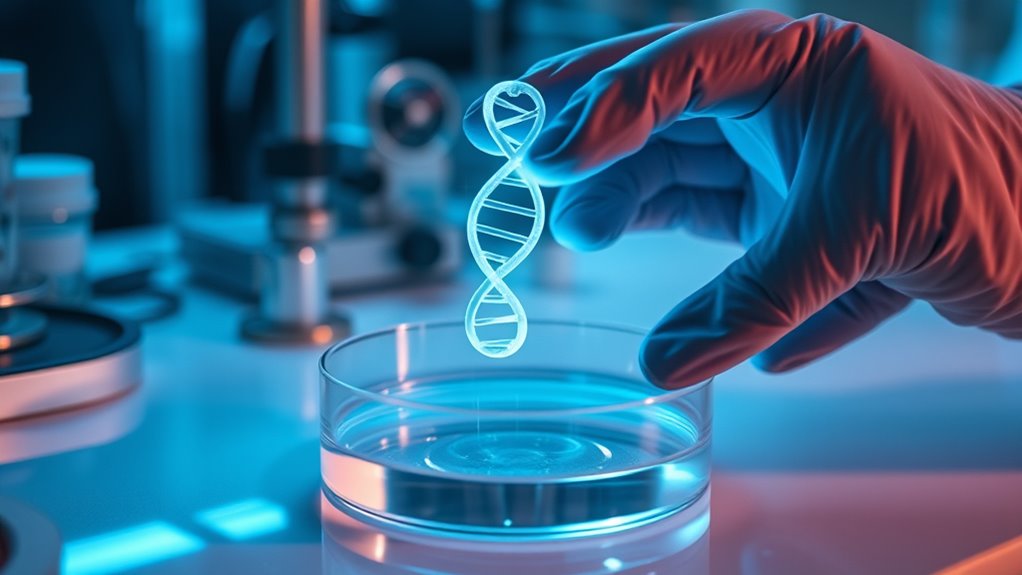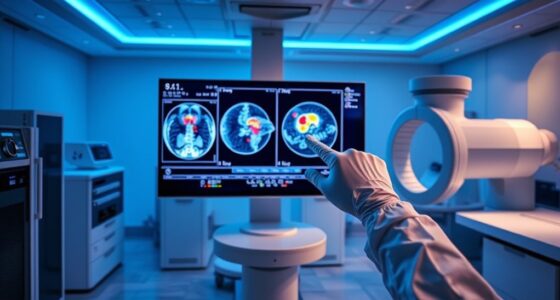CRISPR gene editing uses a precise tool to target and modify specific DNA sequences, allowing you to potentially treat genetic disorders and correct harmful mutations. It works by using a molecular “scissors” guided by a special protein to cut DNA at exact locations. While promising, ethical concerns arise about safety, consent, and the possibility of germline changes that can be passed down. If you want to understand how it impacts society and ethics, keep exploring this powerful technology.
Key Takeaways
- CRISPR uses a molecular tool to precisely target and cut specific DNA sequences for gene editing.
- It works by guiding a enzyme like Cas9 to the desired gene, allowing for modifications or corrections.
- Ethical concerns involve germline editing, which can pass changes to future generations, raising moral questions.
- Risks include off-target effects that may cause unintended genetic mutations and health issues.
- Society must consider regulation, accessibility, and moral implications to ensure responsible use of CRISPR technology.

CRISPR gene editing has revolutionized the way scientists modify DNA, offering precise and efficient tools to alter genetic sequences. This breakthrough technology allows you to target specific genes with remarkable accuracy, opening up new possibilities for treating genetic disorders. One of the most promising applications is genetic therapy, where CRISPR can potentially correct harmful mutations at their source, offering hope to millions suffering from inherited diseases like cystic fibrosis or sickle cell anemia. As powerful as this technology is, it also sparks significant ethical debates. Many wonder whether editing human DNA is a step too far, especially when it comes to germline modifications that can be passed down to future generations. These debates center on concerns about safety, consent, and the potential for unintended consequences. While somatic cell editing—altering only the patient’s body cells—raises fewer ethical issues, germline editing introduces questions about altering the human gene pool and the moral implications of “playing God.” You need to *contemplate* the risks involved; off-target effects, where unintended parts of the genome are edited, could lead to unforeseen health problems. The scientific community is still grappling with establishing strict guidelines to prevent misuse or reckless experimentation. Some argue that the potential benefits outweigh the risks, especially for life-threatening conditions, but others believe that the ethical considerations demand a cautious approach. You should also be aware of the broader societal implications. For instance, if gene editing becomes accessible and affordable, it could lead to a new form of inequality, where only the wealthy can afford genetic enhancements. This raises questions about fairness and the possibility of creating a genetically “enhanced” elite. Additionally, public opinion varies widely, and as a society, you’ll need to decide how to regulate and oversee the use of CRISPR technology responsibly. The debate isn’t just scientific; it’s deeply moral. As researchers continue to refine CRISPR and explore its potential, you must stay informed about the ongoing discussions surrounding its ethical use. Balancing innovation with caution is *indispensable* to *assure* that this revolutionary tool benefits humanity without crossing ethical boundaries. While the promise of genetic therapy is incredible, it’s essential that ethical considerations guide its development and application. Ultimately, CRISPR offers transformative possibilities, but it also challenges you to think carefully about the moral responsibilities that come with manipulating the building blocks of life.
Frequently Asked Questions
Can CRISPR Be Used to Edit Human Embryos Legally?
You can’t legally use CRISPR to modify human embryos in most countries due to strict legal restrictions. These laws aim to prevent unethical embryo modification and ensure safety, so you need to be aware of your local regulations. While researchers are exploring embryo modification for potential benefits, current legal frameworks generally prohibit clinical applications. Always check your country’s specific laws before considering any embryo editing with CRISPR.
What Are the Potential Ecological Impacts of Gene Editing?
You might not realize it, but gene editing can impact ecological balance by affecting genetic diversity. When you modify species, you could unintentionally reduce genetic variation, making ecosystems more vulnerable to diseases or environmental changes. These changes might disrupt food chains or habitats, risking ecosystem stability. So, it’s vital to carefully consider how gene editing might influence ecological health and guarantee that interventions support, rather than harm, natural biodiversity.
How Cost-Effective Is CRISPR Technology for Medical Treatments?
You might think CRISPR is expensive, but it’s actually becoming more cost-effective due to cost reduction and accessibility improvements. As technology advances, treatment costs drop, making gene editing treatments more affordable and accessible to a broader population. This shift promises to revolutionize medicine by providing personalized therapies that were once out of reach, transforming healthcare from exclusive to inclusive.
Are There Risks of Off-Target Effects in CRISPR Editing?
You should know that off-target effects are a real concern with CRISPR editing, posing accuracy challenges that could lead to unintended genetic changes. These risks raise ethical concerns, especially when editing human embryos or germline cells. While scientists work to improve precision, it’s vital to take into account these potential dangers, as unintended edits could cause health issues or ethical dilemmas, making ongoing research and regulation indispensable.
How Do International Laws Regulate CRISPR Research?
International laws regulate CRISPR research through biosafety regulations and guidelines for ethical practices. You should be aware that many countries collaborate internationally to establish standards, ensuring safe and responsible gene editing. These regulations often involve oversight by global organizations and require researchers to follow strict protocols, especially in sensitive areas like human germline editing. Staying informed about international agreements helps you navigate the complex legal landscape surrounding CRISPR advancements.
Conclusion
Think of CRISPR as a powerful compass in your hands, guiding the ship of science through uncharted waters. While it can steer us toward incredible cures and breakthroughs, it also requires careful navigation to avoid dangerous reefs. As you explore this new frontier, remember that with great power comes great responsibility. Use your compass wisely, balancing curiosity with caution, so you can chart a course that benefits all without losing your way in the ethical fog.









